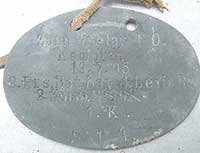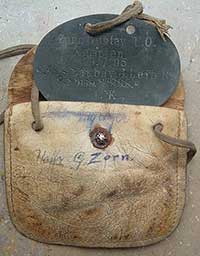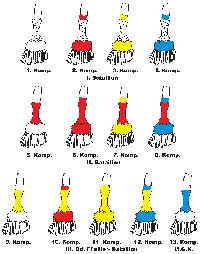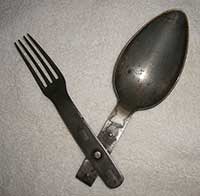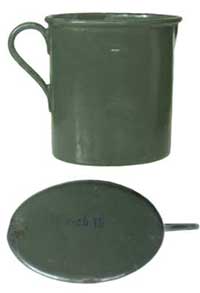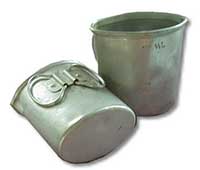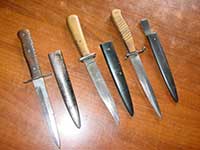Feldmütze (Field Cap)
 Pre-1916 cockades and red band
Pre-1916 cockades and red band
Also called a "Krätzchen" this is the standard EM Feldmütze with red band and red piping. Also allowed is the M.1917 Einheitsfeldmütze which is solid feldgrau but still retains the band and piping detail. The red-banded Feldmütze is what we prefer, but the Einheitsfeldmütze is allowed.
Each have both national (red, white, black) and Bavarian (blue and white) Kokarden (cockades). However in March 1916 the Bavarian cockade style changed for all EM/NCO ranks to a "prong-back" design vs. being sewn on.
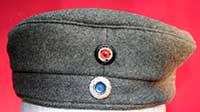 M1917 with M1916 cockades,
M1917 with M1916 cockades,
made of all feldgrau wool
Kokarden
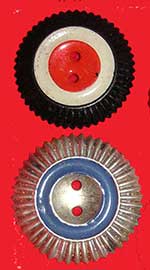 Pre-1916 Kokarden
Pre-1916 Kokarden
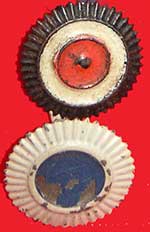 1916-1918 Kokarden
1916-1918 Kokarden
|
Der Stahlhelm (Steel Helmet)
M.1916, M.1917 or M.1918
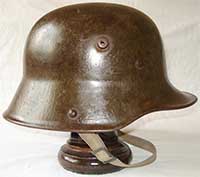 At the beginning of the Great War, the German Army wore the „Helm“ or Pickelhaube (as we call it today). Made of formed leather with metal trim, the Pickelhaube offered the wearer little or no protection against shrapnel, the by-product of the ever increasing use of artillery. Soon, the number of soldier’s with serious head wounds due to shrapnel mounted. These head wounds were found to be far worse than other types of wounds because even if they did heal, they often left the man incapacitated and unable to function. The rising numbers of serious head wounds caused the German High Command to search for a solution. At the beginning of the Great War, the German Army wore the „Helm“ or Pickelhaube (as we call it today). Made of formed leather with metal trim, the Pickelhaube offered the wearer little or no protection against shrapnel, the by-product of the ever increasing use of artillery. Soon, the number of soldier’s with serious head wounds due to shrapnel mounted. These head wounds were found to be far worse than other types of wounds because even if they did heal, they often left the man incapacitated and unable to function. The rising numbers of serious head wounds caused the German High Command to search for a solution.
After much testing and study, the M.1916 Stahlhelm (steel helmet) was issued in limited numbers. With the Stahlhelm, a marked decrease in the shrapnel head wounds was quickly seen and soon, almost all the Frontline units were issued Stahlhelme, beginning at Verdun with its mass introduction to the units fighting there. With the Stahlhelm, the whole look of the German soldier changed—to a look we associate today as “the” German look.
No one knows how many lives were saved by the introduction of the Stahlhelm, but it can be assumed to be a very high number.
Our Requirements
All members must have a M.1916, M.1917 or a M.1918 Stahlhelm, which will be worn during all mid- and late-war scenarios. In Great War reenacting, we wear a Stahlhelm for a reason — WW1 reenacting has working mortars!
The chinstrap and liner must be of the correct pattern for the Stahlhelm worn (i.e. M.18 chinstrap with the M.18 Stahlhelm). Helmet covers, if worn, must be good reproductions of the original German issue. Repainted helmets will be feldgrau color and of the proper finish (no black painted Stahlhelme, etc.).
|
Waffenrock or Feldbluse
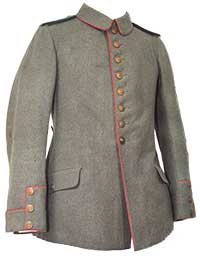 M.1907-10 Feldrock
M.1907-10 Feldrock
The Waffenrock or Feldbluse (called a “tunic” by collectors and most reenactors) is one of the most important parts of your impression—it’s what people see first and it greatly influences their opinion of you and the unit. Your tunic should be acquired first and with the utmost care. Note: These uniform jackets do not fit anything like a civilian suit or any current service uniform of any nation we know of. The following are the key fitting elements of the WWI German uniform: The overall length is long, the arm holes are small and the back is narrow. 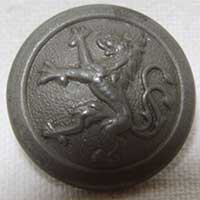 This gives the wearer the overall feeling of smallness in the arm and shoulder area and a form fitting feeling in the body. This feeling is commonly mistaken by reenactors as the jacket size being too small. This is because modern garments (with the exception of fine Italian or European suits) are no longer made to the form fitting method and no one is used to this feeling. This gives the wearer the overall feeling of smallness in the arm and shoulder area and a form fitting feeling in the body. This feeling is commonly mistaken by reenactors as the jacket size being too small. This is because modern garments (with the exception of fine Italian or European suits) are no longer made to the form fitting method and no one is used to this feeling.
Different Model Jackets
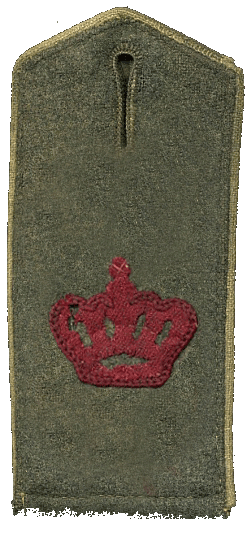 All tunics must have
All tunics must have
the proper piping and
buttons and be complete
with our unit's Achselklappen
(shoulder boards)
one of which is shown above.
During the Great War there were three basic styles of tunics used by the German Army—the M.1907/10, the M.1914 "Vereinfacht" (also called the "Transitional") and the 1916 (much the same as the Prussian M.1915 "die Bluse"). Either the 1910, 1916 or Transitional patterns are acceptable for use in the Lei Rgt. Each must exhibit the appropriate buttons and fastenings as well as the Crown shoulder boards, with proper Kompagnie buttons.
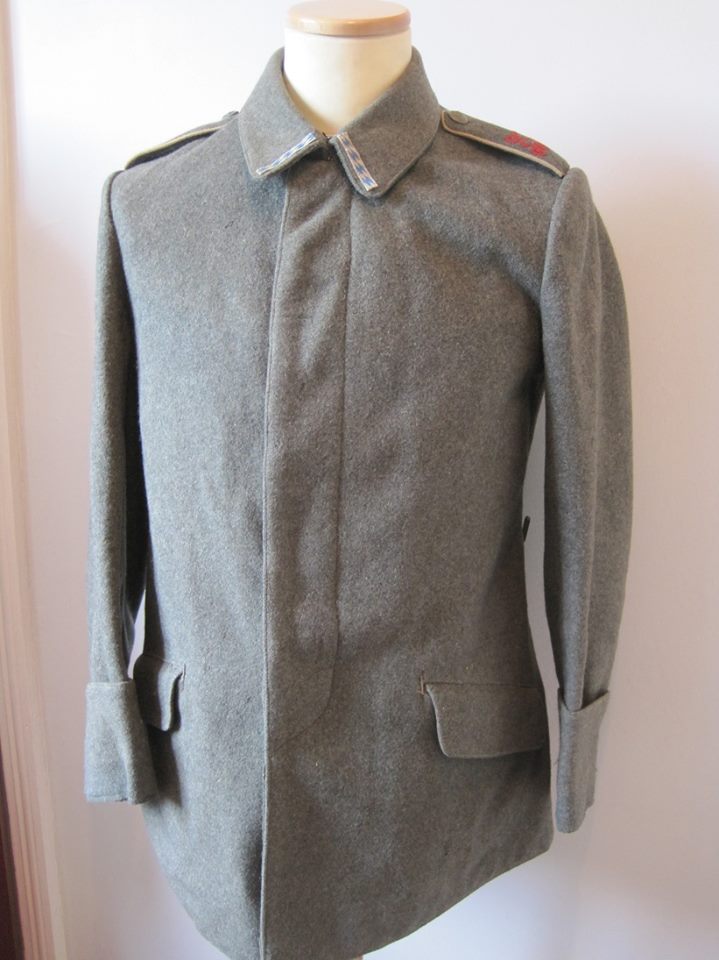 Bavarian M.1916 Bluse
Bavarian M.1916 Bluse
|
M.1915 Tuchhosen (Trousers)
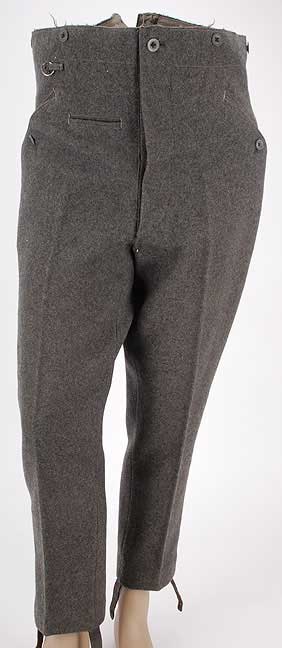 The trousers were made of the same field grey material as the tunic and cap. They were basically straight-legged, fairly narrow fitting, and were very slightly flared through the thighs. They had a fly front closed with horn buttons. Cut with a very high waist—they came almost to the bottom of the rib cage—there was a belt from side-seam to side-seam across the rear that permitted finer adjustment at the waist. On the front, inserted at an angle, there was an internal slash pocket on each side. Small horn buttons closed these. Additionally, there was a small slash watch pocket on the right waist. Beginning several inches below the top edge, a line of ponceau piping ran down the side seams of each leg. Trousers were lined at the waistband generally with materials similar to that used in tunics. Along the upper edge—which was usually unfinished (raw)—zinc dish buttons were spaced to provide attachment points for the suspenders; there were no belt loops. Bottoms were turned inward, and the hem was usually quite deep. The trousers were made of the same field grey material as the tunic and cap. They were basically straight-legged, fairly narrow fitting, and were very slightly flared through the thighs. They had a fly front closed with horn buttons. Cut with a very high waist—they came almost to the bottom of the rib cage—there was a belt from side-seam to side-seam across the rear that permitted finer adjustment at the waist. On the front, inserted at an angle, there was an internal slash pocket on each side. Small horn buttons closed these. Additionally, there was a small slash watch pocket on the right waist. Beginning several inches below the top edge, a line of ponceau piping ran down the side seams of each leg. Trousers were lined at the waistband generally with materials similar to that used in tunics. Along the upper edge—which was usually unfinished (raw)—zinc dish buttons were spaced to provide attachment points for the suspenders; there were no belt loops. Bottoms were turned inward, and the hem was usually quite deep.
A Change
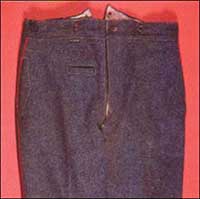 On 27 August 1914, the following changes to the field uniform were ordered: Trousers were in the future, to be made of steingrau (stone grey — a deeper gray shade) material vs. feldgrau (field grey) which is grener. This move had been in discussion before the war in that trousers and tunics presented a poor match since the trousers faded more rapidly from rougher wear and more frequent laundering. As such, a contrasting shade was chosen, removing the need to match existing garments. The pattern remained otherwise unaltered. On 27 August 1914, the following changes to the field uniform were ordered: Trousers were in the future, to be made of steingrau (stone grey — a deeper gray shade) material vs. feldgrau (field grey) which is grener. This move had been in discussion before the war in that trousers and tunics presented a poor match since the trousers faded more rapidly from rougher wear and more frequent laundering. As such, a contrasting shade was chosen, removing the need to match existing garments. The pattern remained otherwise unaltered.
|
Hemd (Shirt)
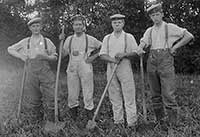 The issue shirt is a white collarless pullover type that were issued to all troops. However, civilian shirts of period style are also worn and thus correct. Remember, it's the Germans and really, there is a wide latitude for uniformity. The issue shirt is a white collarless pullover type that were issued to all troops. However, civilian shirts of period style are also worn and thus correct. Remember, it's the Germans and really, there is a wide latitude for uniformity.
|
|
Halsbinde (neck stock)
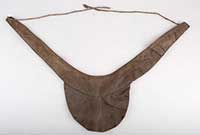 The Halsbinde is made of a grey or grey-green cloth, tied around the neck to protect the wool collar from sweat and wear — not the soldier's neck from the wool. The Halsbinde is made of a grey or grey-green cloth, tied around the neck to protect the wool collar from sweat and wear — not the soldier's neck from the wool.
|
Schnürschuhe or Marschstiefeln (Shoes or Jackboots)
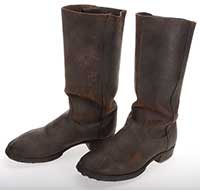 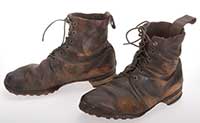 Schnürschuhe (L) or Marschstiefeln (R) (Shoes or Jackboots) assault troops were given ankle boots as standard issue and all troops later on were issued them. German, British, French, US, Swedish ankle boots are acceptable, but must be hobnailed and have heel irons. Jackboots are useable for early war events and as backup footwear at late war events. Schnürschuhe (L) or Marschstiefeln (R) (Shoes or Jackboots) assault troops were given ankle boots as standard issue and all troops later on were issued them. German, British, French, US, Swedish ankle boots are acceptable, but must be hobnailed and have heel irons. Jackboots are useable for early war events and as backup footwear at late war events.
[[Add Gebirgsschuhe]]
|
Gamaschen (Puttees)
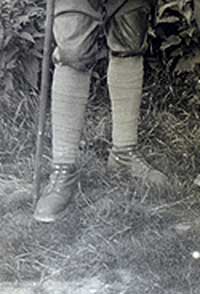 Known as wrap leggings or puttees, they will be of feldgrau, steingrau, or black wool. The top end will have twill tape or woolen ties with a buckle. At the other end a small hook to attach to the shoe. Known as wrap leggings or puttees, they will be of feldgrau, steingrau, or black wool. The top end will have twill tape or woolen ties with a buckle. At the other end a small hook to attach to the shoe.
|
Koppel und Koppelschloss (Belt & Buckle)
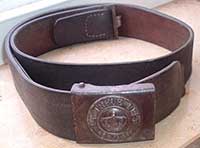 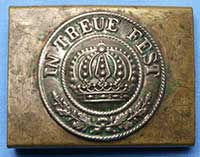 Belts will be of brown or black leather with adjustment tongue. Buckles will be brass or brass and Tombac (early war) or steel (bare or painted feldgrau) for late-war) and all of the “Im Treue Fest” pattern. Belts will be of brown or black leather with adjustment tongue. Buckles will be brass or brass and Tombac (early war) or steel (bare or painted feldgrau) for late-war) and all of the “Im Treue Fest” pattern.
|
Brotbeutel und Brotbeutelriemen (Breadbag and breadbag strap)
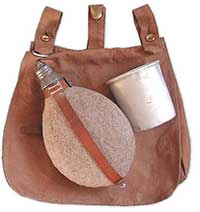 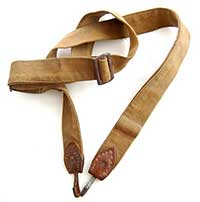 Brown ochre (early war) or grey in color. WWI examples a single “D” ring and leather loop. WWII bread bags are not acceptable. Brown ochre (early war) or grey in color. WWI examples a single “D” ring and leather loop. WWII bread bags are not acceptable.
[*Note: Unlike in WWII, WWI German troops were not issued “Y” straps for the equipment waistbelt. Instead the breadbag strap was used and hooked to each cartridge box and passed behind the neck. West German, WWII and originals are acceptable.]
|
Feldflasche (Canteen)
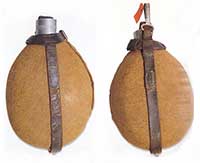 M.1907 Feldflasche
M.1907 Feldflasche
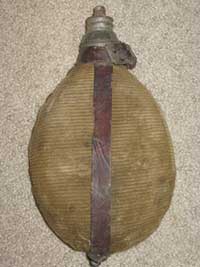 M.1896 Feldflasche
M.1896 Feldflasche
Standard WWI issue is the only acceptable type. WWII and medical canteens are not to be used.
|
Seitengwewehr (Bayonet)
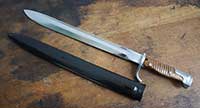 Though an enormous variety of bayonets were used. It is urged that members use the S.98/05na (butcher) pattern with sawteeth. The sawtooth bayonet was standard issue to Pionier troops. The smaller WWII looking sawtooth was more commonly used by NCO’s. Each bayonet must be complete with its appropriate scabbard and frog. Though an enormous variety of bayonets were used. It is urged that members use the S.98/05na (butcher) pattern with sawteeth. The sawtooth bayonet was standard issue to Pionier troops. The smaller WWII looking sawtooth was more commonly used by NCO’s. Each bayonet must be complete with its appropriate scabbard and frog.
|
Kochgeschirr (Mess Tin)
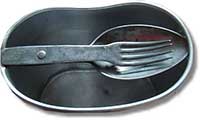 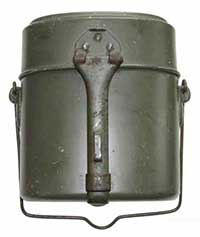 Enameled steel or painted aluminum large WWI pattern. Post WWI and late 1930’s types are nearly identical and, as such, perfectly acceptable. WWII, East German (DDR) and Bundeswehr tins are not allowed. Enameled steel or painted aluminum large WWI pattern. Post WWI and late 1930’s types are nearly identical and, as such, perfectly acceptable. WWII, East German (DDR) and Bundeswehr tins are not allowed.
|
Schanzzeug und Schanzzeugtasche
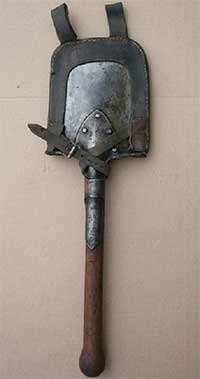 (Entrenching Tool and Carrier)—As the Great War devolved into sustained trench warfare, the entrenching tool became more and more important. The Schanzzeug that the ordinary Infanterie Soldat carried was the short infantry shovel (Kleines Spaten für Infanterie). The Spaten had a straight handle with a ball shaped end. The blade was square shaped and usually had one edge sharpened which made it into a very deadly trench weapon. (Entrenching Tool and Carrier)—As the Great War devolved into sustained trench warfare, the entrenching tool became more and more important. The Schanzzeug that the ordinary Infanterie Soldat carried was the short infantry shovel (Kleines Spaten für Infanterie). The Spaten had a straight handle with a ball shaped end. The blade was square shaped and usually had one edge sharpened which made it into a very deadly trench weapon.
One Soldat in 19 was issued with the Combination Pick-Axe (Beilpicke für Infanterie). Also issued were Wire-cutters (Drahtschere), Field Hatchet (Feldbeil für Infanterie), Pionier Saw (Pionier Faltsäge), long Pionier Shovel (Pionier Spaten) and Pionier Pick (Kreuzhacke).
Regulations said that each Kompagnie was to be issued 100 Kleines Spaten, 13 Beilpicke and 5 Kreuzhacke with covers. [The amounts of the other entrenching tools are not specified, but can be assumed to be on par with the Beilpicke.]
What We Require
Soldiers must have a proper M.1887 Infantry Shovel and its correct leather harness. Original Schanzzeuge are, of course, acceptable along with similarly constructed Swiss, French or other European entrenching tools. East German shovels are acceptable as long as they are of the type with the shovel blade riveted onto the head (as opposed to its being welded on). If you would like to carry one of the alternate entrenching tools, you must first get permission from your unit leader. All entrenching tools should be able to be used for the task they were designed.
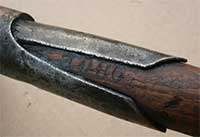 Infanterie Spaten detail
Infanterie Spaten detail
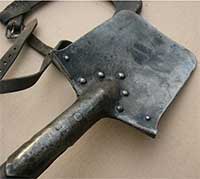 Infanterie Spaten
Infanterie Spaten
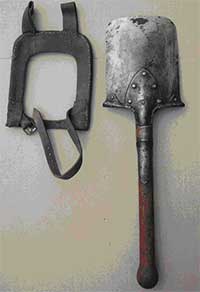 Infanterie Spaten and Tasche
Infanterie Spaten and Tasche
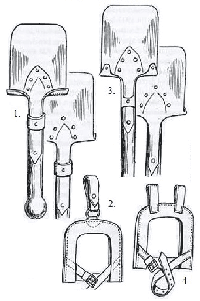
- M.1874 Spaten
- M.1874 carrier
- M.1898/09 Spaten
- M.1909 Carrier
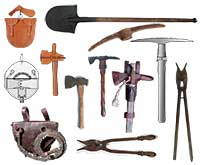 We'll be covering more of the Infanterie entrenching tools in
We'll be covering more of the Infanterie entrenching tools in
detail later, but click on this thumbnail
to look at this art for a little info
Other Schanzeuge
Coming soon...
|
Zeltbahn (Tent Half)
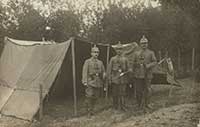 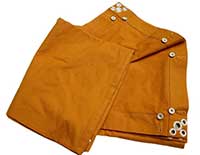 Ochre (early war) or field grey are allowed. Must have proper buttons and grommets. Repros are readily available Ochre (early war) or field grey are allowed. Must have proper buttons and grommets. Repros are readily available
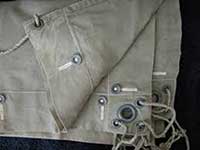
|
Gas Mask and
Gas Mask Cannister
(Gasmaske und Gasmaskentragebüchse) — Gas masks became standard issue to German troops in August 1915. There are two kinds of repro Gasmasks that reenactors will see (and use) and that’s what we’ll cover here: The Gasschutzmaske M.15 (Gummimaske to collectors and reenactors) and the Gasmaske M.17 (Lederschutzmaske to collectors and reenactors; not being reproed at this time).
Note: After 1916, you would rarely have seen frontline Soldaten with a full beard. Generally, men were either clean-shaven, had moustaches or, at the most, had a goatee. This can easily be substantiated by looking at period photographs; the reason for this being so that the Gasmaske would seal properly to the face.
The Gasschutzmaske M.15
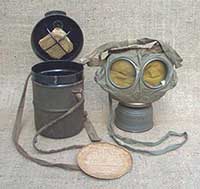 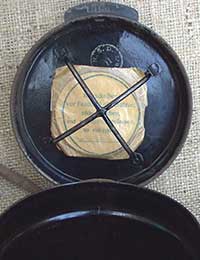 The Gummimaske was made of impermeable rubberized cotton fabric. The stamped round metal frames in eye glasses were made of unbreakable and non-combustible celluloid. The mask was held on the head by two elastic bands. A neck strap allows the gas mask to worn ready for use. Initially, the mask was stored in the breadbag, then later, a gray canvas bag was introduced. In 1916 the storage can carried in the canvas bag was fitted with two straps, sometimes made of „ersatz“ paper-cloth. The original paper-cloth straps were strong and durable but over the years, have become fragile and will no longer hold-up in the trenches! Soldiers were also issued an extra filter with a cloth carrier worn on the belt. The Gummimaske was made of impermeable rubberized cotton fabric. The stamped round metal frames in eye glasses were made of unbreakable and non-combustible celluloid. The mask was held on the head by two elastic bands. A neck strap allows the gas mask to worn ready for use. Initially, the mask was stored in the breadbag, then later, a gray canvas bag was introduced. In 1916 the storage can carried in the canvas bag was fitted with two straps, sometimes made of „ersatz“ paper-cloth. The original paper-cloth straps were strong and durable but over the years, have become fragile and will no longer hold-up in the trenches! Soldiers were also issued an extra filter with a cloth carrier worn on the belt.
Changes and the Gasmakse M.17
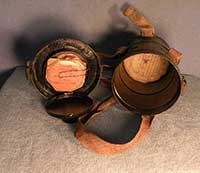 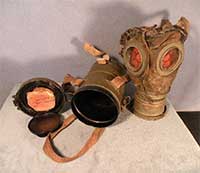 As the war progressed, the effects of the British blockade were felt and Germany ran short of rubber., The rubberized cotton fabric of the Gummimaske began to be replaced by chrome-tanned sheepskin, bought from Bulgaria. The first step was to dip it into sealing oil to render it waterproof. Next, a single piece was cut from the hide and rolled into a cone and cut in three places. Then the seams stitched and lacquered. The seams were cut to allow the lenses to stand clear of the face like goggles. The eye pieces were double-layered (celluloid and cellulose acetate respectively) and coated on the inside with gelatine to prevent misting-up. The coating replaced the wiping folds of the fabric mask and so reduced the dead air space in the mask. The face line was made airtight by fabric-covered, twisted piano wire springs which, it was said, were as good as the earlier elastic tape. Although ingeniously designed, the Gasmaske M.17 (Lederschutzmaske) was inferior to the earlier Gummimaske The leather was smelly and rough, it was also stiffer and a good fit was therefore more difficult to achieve. The Lederschützmaske did not dry quickly and could not be patched with rubber solution, and had to be carefully stowed in its canister to avoid chafing the seams. As if this were not enough, the eyepieces angled differently from the Gummimaske which the solders had become accustomed. One could get used to that but aiming was difficult. As the war progressed, the effects of the British blockade were felt and Germany ran short of rubber., The rubberized cotton fabric of the Gummimaske began to be replaced by chrome-tanned sheepskin, bought from Bulgaria. The first step was to dip it into sealing oil to render it waterproof. Next, a single piece was cut from the hide and rolled into a cone and cut in three places. Then the seams stitched and lacquered. The seams were cut to allow the lenses to stand clear of the face like goggles. The eye pieces were double-layered (celluloid and cellulose acetate respectively) and coated on the inside with gelatine to prevent misting-up. The coating replaced the wiping folds of the fabric mask and so reduced the dead air space in the mask. The face line was made airtight by fabric-covered, twisted piano wire springs which, it was said, were as good as the earlier elastic tape. Although ingeniously designed, the Gasmaske M.17 (Lederschutzmaske) was inferior to the earlier Gummimaske The leather was smelly and rough, it was also stiffer and a good fit was therefore more difficult to achieve. The Lederschützmaske did not dry quickly and could not be patched with rubber solution, and had to be carefully stowed in its canister to avoid chafing the seams. As if this were not enough, the eyepieces angled differently from the Gummimaske which the solders had become accustomed. One could get used to that but aiming was difficult.

The Tragebüchse is a short, circular canister with a wire clip latch. It has a two part carrying strap, sometimes made of „ersatz“ paper-cloth. It is important to remove original paper-cloth strap from the Tragbüchse—although strong and durable when new, original paper-cloth becomes fragile over time and they will no longer hold-up in the trenches! Soldiers were also issued an extra filter with a cloth belt carrier worn on the belt.
Each member shall carry a proper WWI German Gasmaske (either original or good repro) with the appropriate canister. The spare filter carrier is optional.
 This is NOT WWII reenacting, members need to have and carry a gasmask! This is NOT WWII reenacting, members need to have and carry a gasmask!
 Important: It is a very good idea to remove and disassemble the original filter on your mask and clean out the interior, as they occasionally still have traces of poison gases such as phosgene in them. If you happen to breath in this gas residue, it can still damage your lungs even after all these years! Also, asbestos was used as one of the filter components and should therefore be removed. Important: It is a very good idea to remove and disassemble the original filter on your mask and clean out the interior, as they occasionally still have traces of poison gases such as phosgene in them. If you happen to breath in this gas residue, it can still damage your lungs even after all these years! Also, asbestos was used as one of the filter components and should therefore be removed.
If you are interested in the history, design and wear of the myriad of German gasmasks, I would suggest La Guerre Des Gaz 1915-1918 by Patrice Delhomme available exclusively from Great War Militaria. There is also an Osprey book called World War I Gas Warfare Tactics and Equipment. Last, there is a good article by Randall Chapmann of IR63 in their newsletter -- I’m sure he would send to you
|
M.1909 Patronentaschen (cartridge pouches)
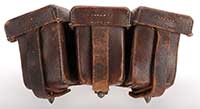 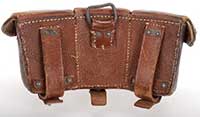 In pebbled-finish brown leather. Each of the six pouches, in two sets of three, holds three five-round clips of 7.92x57mm cartridges, giving a total of 90 rounds. The weight is distributed by means of a ring mounted behind each triple pouch, hooking to the front shoulder-strap of the Tornister pack. In pebbled-finish brown leather. Each of the six pouches, in two sets of three, holds three five-round clips of 7.92x57mm cartridges, giving a total of 90 rounds. The weight is distributed by means of a ring mounted behind each triple pouch, hooking to the front shoulder-strap of the Tornister pack.
|
Karabiner 98

Karabiner 98A (Kar98a carbine) The Kar98a carbine was standard issue to Pioniere as well as Stoßtruppen. We prefer, especially, for those in the frontlines, that they carry a Kar98a, but, as they are getting crazy-expensive, we allow the standard Gew.98 to be carried until a Kar98a is obtained.
Gewehr 98 mit Schulterriemen
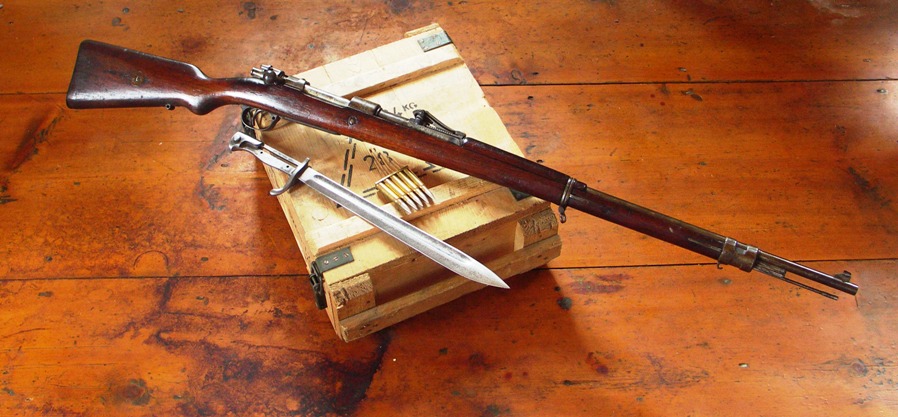
Gewehr 98 Mauser with Sling (Rifle, M.1898) —The Gewehr 98 was the standard service weapon for the German Army during WWI and one which was familiar to all of Germany’s servicemen.
The Gew. 98 is an internal-magazine-fed, bolt-action rifle, with a capacity for five rounds of ammunition. The ammunition that the Gew. 98 is chambered for is the standard German 7.92 x 57mm round.
Each rifle will be complete with a sling, parade clip and cleaning rod. The Gew. 98 also must have the “Lange” type rear sight (called the “roller coaster” sight by collector dorks).
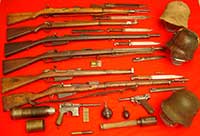 Grouping of German WWI weapons.
Grouping of German WWI weapons.
|

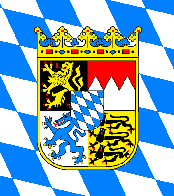










 This gives the wearer the overall feeling of smallness in the arm and shoulder area and a form fitting feeling in the body. This feeling is commonly mistaken by reenactors as the jacket size being too small. This is because modern garments (with the exception of fine Italian or European suits) are no longer made to the form fitting method and no one is used to this feeling.
This gives the wearer the overall feeling of smallness in the arm and shoulder area and a form fitting feeling in the body. This feeling is commonly mistaken by reenactors as the jacket size being too small. This is because modern garments (with the exception of fine Italian or European suits) are no longer made to the form fitting method and no one is used to this feeling. The trousers were made of the same field grey material as the tunic and cap. They were basically straight-legged, fairly narrow fitting, and were very slightly flared through the thighs. They had a fly front closed with horn buttons. Cut with a very high waist—they came almost to the bottom of the rib cage—there was a belt from side-seam to side-seam across the rear that permitted finer adjustment at the waist. On the front, inserted at an angle, there was an internal slash pocket on each side. Small horn buttons closed these. Additionally, there was a small slash watch pocket on the right waist. Beginning several inches below the top edge, a line of ponceau piping ran down the side seams of each leg. Trousers were lined at the waistband generally with materials similar to that used in tunics. Along the upper edge—which was usually unfinished (raw)—zinc dish buttons were spaced to provide attachment points for the suspenders; there were no belt loops. Bottoms were turned inward, and the hem was usually quite deep.
The trousers were made of the same field grey material as the tunic and cap. They were basically straight-legged, fairly narrow fitting, and were very slightly flared through the thighs. They had a fly front closed with horn buttons. Cut with a very high waist—they came almost to the bottom of the rib cage—there was a belt from side-seam to side-seam across the rear that permitted finer adjustment at the waist. On the front, inserted at an angle, there was an internal slash pocket on each side. Small horn buttons closed these. Additionally, there was a small slash watch pocket on the right waist. Beginning several inches below the top edge, a line of ponceau piping ran down the side seams of each leg. Trousers were lined at the waistband generally with materials similar to that used in tunics. Along the upper edge—which was usually unfinished (raw)—zinc dish buttons were spaced to provide attachment points for the suspenders; there were no belt loops. Bottoms were turned inward, and the hem was usually quite deep.
































